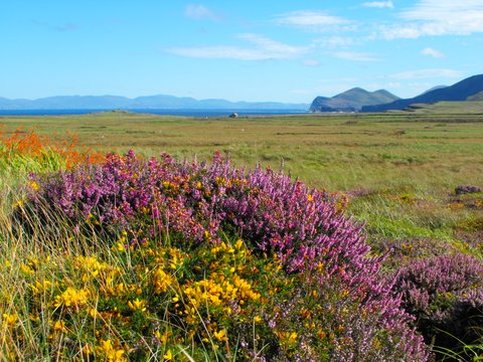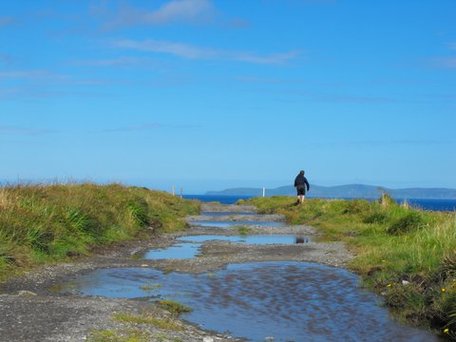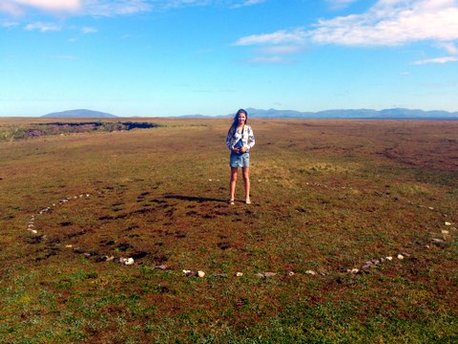
Working in the Landscape
I am looking at the interplay between artist and landscape, exploring themes of longevity, uncertainty, scale, manipulation of materials integral to the setting, and personal involvement. I use writing to illustrate my approach to some of these themes. Here is the recipe for a stone circle created on the west coast of Ireland. The circle was started 12 years ago, but the writing is new.
Making a stone circle. Take two children, one four-year-old, a sturdy walker, the other a baby on your right hip. Add a rucksack containing nappies, water, tiffin, binoculars, macs (always macs, even if the sun is shining). Two grandparents, also sturdy walkers. Set off down a long path bounded by tall banks of green, pink, purple, yellow, orange and white, with barbed wire threaded through the plants. The banks become low, the wire stops and the child can run along the top, startling frogs. To each side stretch peat bogs topped with cotton-grass. Walk for a mile until you reach the end of the track. The Atlantic cliff edge means that you have gone far enough. You are on flat land stretching away to mountains on each side. This is the “Back of the Island”, also called “Paris”. You are not sure why.
There are low, flat islands ahead, but far away. The waves hit the slate cliffs with blue, turquoise and white. Turn right and find a patch of flat peat, green with springy Thrift. Give the baby to his grandfather, sitting not too close to the edge. Watch the child all the time. Collect pieces of flat slate (about the size of your hand) and white quartz. Arrange in a circle about 12 feet wide. Place and kick the pieces into alignment. The child dances around the edge, then jumps in and out across the new line. There is inside and outside when previously there was not. The circle is large for the child but tiny in the expanse of green.
Next year return. Be surprised that the circle is still there. Be pleased. You’re all pleased. Some stones are out of position. Put them back and add others. Return every year at the same time. The children grow. The circle stays the same size. Every year stones are added and the line is filled in, but it never gets any thicker. Sometimes choughs turn the stones over to eat the bugs beneath, but you can always find the circle. Some stones are now embedded in the peat. Put others on top of them. The circle now has some depth. You all become aware of the circle as a thing special to the family. You start to take photographs. The children have seen Time Team and think that the stone circle has “ritual significance”, which you suppose it does now, more than when it was first built. The significance grows with the age of the circle. Its survival and your annual return have given it power. It has started to matter. Now you don’t have to watch the children closely, they are fifteen and eleven. You can watch the gannets punching a hole in the water. You don’t have to carry nappies. You still have to carry macs.
I am looking at the interplay between artist and landscape, exploring themes of longevity, uncertainty, scale, manipulation of materials integral to the setting, and personal involvement. I use writing to illustrate my approach to some of these themes. Here is the recipe for a stone circle created on the west coast of Ireland. The circle was started 12 years ago, but the writing is new.
Making a stone circle. Take two children, one four-year-old, a sturdy walker, the other a baby on your right hip. Add a rucksack containing nappies, water, tiffin, binoculars, macs (always macs, even if the sun is shining). Two grandparents, also sturdy walkers. Set off down a long path bounded by tall banks of green, pink, purple, yellow, orange and white, with barbed wire threaded through the plants. The banks become low, the wire stops and the child can run along the top, startling frogs. To each side stretch peat bogs topped with cotton-grass. Walk for a mile until you reach the end of the track. The Atlantic cliff edge means that you have gone far enough. You are on flat land stretching away to mountains on each side. This is the “Back of the Island”, also called “Paris”. You are not sure why.
There are low, flat islands ahead, but far away. The waves hit the slate cliffs with blue, turquoise and white. Turn right and find a patch of flat peat, green with springy Thrift. Give the baby to his grandfather, sitting not too close to the edge. Watch the child all the time. Collect pieces of flat slate (about the size of your hand) and white quartz. Arrange in a circle about 12 feet wide. Place and kick the pieces into alignment. The child dances around the edge, then jumps in and out across the new line. There is inside and outside when previously there was not. The circle is large for the child but tiny in the expanse of green.
Next year return. Be surprised that the circle is still there. Be pleased. You’re all pleased. Some stones are out of position. Put them back and add others. Return every year at the same time. The children grow. The circle stays the same size. Every year stones are added and the line is filled in, but it never gets any thicker. Sometimes choughs turn the stones over to eat the bugs beneath, but you can always find the circle. Some stones are now embedded in the peat. Put others on top of them. The circle now has some depth. You all become aware of the circle as a thing special to the family. You start to take photographs. The children have seen Time Team and think that the stone circle has “ritual significance”, which you suppose it does now, more than when it was first built. The significance grows with the age of the circle. Its survival and your annual return have given it power. It has started to matter. Now you don’t have to watch the children closely, they are fifteen and eleven. You can watch the gannets punching a hole in the water. You don’t have to carry nappies. You still have to carry macs.


